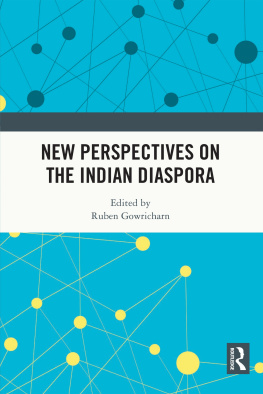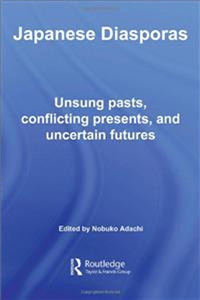
MULTIPLE HOMEMAKING
This book develops a theoretical perspective on homemaking as the ethnic condition of Indian diaspora communities. It draws on empirical case studies to elucidate the multiple homemaking practices of two overseas Indian groups and their relations to their homeland, namely the Surinami Hindustanis and the Dutch Hindustanis. In doing so, it provides a new perspective on homemaking that captures ethnogenesis, integration and diasporic bonding at once. As opposed to the extant discourse on homemaking which overlooks institutional and cultural requirements, the author makes a point to scrutinise such concepts as douglarisation, groupism, citizenship, institutions, ethnification, social networks and technology, and transnational flows.
Unique and compelling, the book will be highly useful in studies of diaspora, globalisation and transnational migration, multiculturalism, cultural studies, ethnic minority studies, sociology, politics and international relations, and South Asian studies.
Ruben Gowricharn is Professor of Indian Diaspora Studies at the VU University in Amsterdam, the Netherlands. He has published extensively on diasporas, democracy and the integration of ethnic minorities. He has edited several books including Shifting Transnational Bonding in Indian Diaspora (2020) and Political Integration in Indian Diaspora Societies (2020). He is also the managing director of a doctoral program for adult migrant students in the Netherlands and Suriname.
First published 2021
by Routledge
2 Park Square, Milton Park, Abingdon, Oxon OX14 4RN
and by Routledge
52 Vanderbilt Avenue, New York, NY 10017
Routledge is an imprint of the Taylor & Francis Group, an informa business
2021 Ruben Gowricharn
The right of Ruben Gowricharn to be identified as author of this work has been asserted by him in accordance with sections 77 and 78 of the Copyright, Designs and Patents Act 1988.
All rights reserved. No part of this book may be reprinted or reproduced or utilised in any form or by any electronic, mechanical, or other means, now known or hereafter invented, including photocopying and recording, or in any information storage or retrieval system, without permission in writing from the publishers.
Trademark notice: Product or corporate names may be trademarks or registered trademarks, and are used only for identification and explanation without intent to infringe.
British Library Cataloguing-in-Publication Data
A catalogue record for this book is available from the British Library
Library of Congress Cataloging-in-Publication Data
Names: Gowricharn, Ruben S., 1952 author.
Title: Multiple homemaking : the ethnic condition in Indian diaspora
societies / Ruben Gowricharn.
Description: Abingdon, Oxon ; New York, NY : Routledge, 2021. |
Includes bibliographical references and index.
Subjects: LCSH: East IndiansForeign countriesSocial conditions. |
East IndiansForeign countriesEthnic identity. | East Indian
diaspora. | Transnationalism.
Classification: LCC DS432.5 .G68 2021 (print) | LCC DS432.5
(ebook) | DDC 305.8914dc23
LC record available at https://lccn.loc.gov/2020024936
LC ebook record available at https://lccn.loc.gov/2020024937
ISBN: 978-0-367-43254-6 (hbk)
ISBN: 978-1-003-00208-6 (ebk)
Typeset in Sabon
by Apex CoVantage, LLC
Nowadays, immigrant settlement has developed into several subdisciplines, all adopting concepts such as integration, belonging, incorporation and homemaking. Most of these perspectives endeavour to construct general-isable theories, while assuming a fashionable malleability, rationality and constructionism. Moreover, the theorists make use of patchy knowledge: they weave insights derived from several ethnic groups to arrive at a general statement. For decades I felt highly dissatisfied with that mode of scholarship. My dissatisfaction pertains to the patchy nature of the statements thus derived at and the presupposed malleability of the culture of ethnic groups. The first constructed outcomes were determined by disparate contexts, traditions and institutions, often at different points of time and locations, while the last of these seems to be changing, but with certain margins, often countervailed by other forces and directed by leadership. These determinants of ethnic cohesion and change require a historical mode of analysis, balancing forces and counterforces, and highlighting the role of context and actors.
All the sources of dissatisfaction could be conveniently addressed when dealing with the issue of homemaking. This homemaking is often considered a once-and-for-all process, but after studying the process of settlement I concluded that every group makes its own home, that this home has multiple dimensions and that it comprises the second and later generations, although every generation may prefer another identity kit. Acculturation, enculturation and transnational bonding, to name just a few examples, shape identity and the ethnic home to a significant degree. This book adopts a historical perspective to avoid the habit of constructing arguments based on patchy knowledge while highlighting how an ethnic group historically managed its identity and feeling of multiple homemaking. For that reason, the multiple homemaking of the selected ethnic group, the Surinamese and Dutch Hindustani, an Indian diaspora community, is analysed historically, thereby avoiding the blending of patchy knowledge.
The book argues that there is more than one form of homemaking as every group has its own form at differents points of time. Furthermore, within a group the homemaking at one moment assumes different forms, hence the homemaking is a multiple phenomenon. For example, homemaking in the sphere of food, or home decoration, or religious homemaking, or social intercourse, represents different dimensions of life that can be addressed separately. That makes the selection of the topics in this book arguable, but together they make the case for differential and multiple forms of specific homemaking. Finally, homemaking is not restricted to one generation, but extends to the next and later generations of immigrants. From this perspective it is a defendable position to address the homemaking of the native population as well, who adjust to the changing society.
The book consists of eight chapters that have been researched using multiple techniques and methodologies. The story of homemaking is told in chronological order, while every chapter deals with a different kind of homemaking. This organisation of the book allows each chapter to be read separately. Some of the chapters have been published before and are reworked for the purpose of the book. This is true for was published as Shopping in Mumbai: Transnational Sociability from the Netherlands, in Global Networks, 2017, Vol. 17, no. 3. The three remaining chapters have been written for this book.
Since some of the chapters have been published before, there is some overlap, especially when it comes to the researched techniques and the description of the researched population. However, as every chapter addresses a different dimension of homemaking as well as a different historical period, the chapters can be read separately as an independent text. Some chapters were written a few years ago. Since then, circumstances in India and in Western societies have changed, for example the name of the Mumbai based Zee satellite television station. I left as much as possible unchanged and dropped or reformulated only some passages to make the text fit in the framework of the book.







